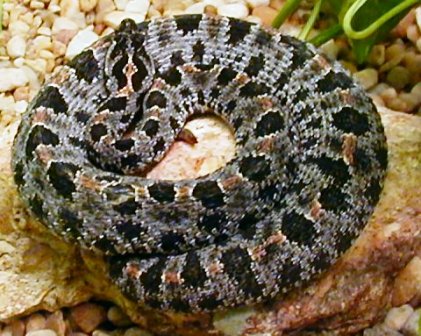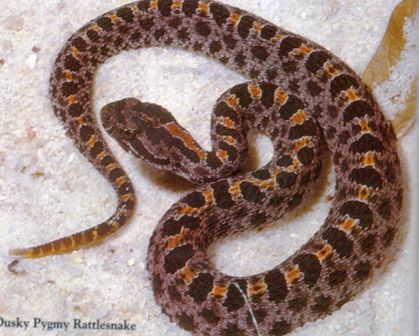Discover Florida Nature
It's time to explore the natural Florida


|
|
|
|
|
 The
Feisty little dusky pygmy rattler is rarely longer than twenty inches,
and is common throughout the state of Florida. This small rattler lives
in pine-palmetto
flatwoods,
scrub, and longleaf
pine habitats that are not far from fresh water. The Dusky Pygmy
Rattlesnake is a hot-tempered snake, usually striking repeatedly at the
slightest threat. This pit vipers venom is very potent but the dose it
delivers is small. Although the Pygmy Rattler vibrates its tail when
annoyed, the little rattles are barely audible, sounding more like the
faint buzz of an insect. This is all the more reason to be wary of this
snake. Although its bite is unlikely to cause death, it can be very
painful and can cause infection or tissue destruction. The
Feisty little dusky pygmy rattler is rarely longer than twenty inches,
and is common throughout the state of Florida. This small rattler lives
in pine-palmetto
flatwoods,
scrub, and longleaf
pine habitats that are not far from fresh water. The Dusky Pygmy
Rattlesnake is a hot-tempered snake, usually striking repeatedly at the
slightest threat. This pit vipers venom is very potent but the dose it
delivers is small. Although the Pygmy Rattler vibrates its tail when
annoyed, the little rattles are barely audible, sounding more like the
faint buzz of an insect. This is all the more reason to be wary of this
snake. Although its bite is unlikely to cause death, it can be very
painful and can cause infection or tissue destruction.The Dusky Pygmy Rattlesnake is a small snake, but very thick for its size. The top of the triangular shaped head is covered with nine large scales. The body color is light to dark gray. A longitudinal row of black or charcoal, transverse blotches disrupts a reddish brown stripe running down the middle of the back. Dark spots on the side line up with the blotches. The tail is slender and ends in a miniature rattle. The belly is heavily mottled with black and white. All five of Florida's deadly pit vipers, including the Dusky Pygmy Rattlesnake can be recognized by their stocky bodies, relatively small necks, large triangular heads, and eyes with vertical slit pupils. Like all pit vipers, the Pygmy Rattler has is a deep facial pit between the nostril and the eye. The facial pits are extremely sensitive heat-detecting organs, with which the rattler can home in on warm blooded prey. The pit organs can detect differences in temperatures as small as three one-thousandths of a degree centigrade! Pit vipers produce a hemotoxic venom that destroys the blood cells of both warm-blooded and cold-blooded animals. Since there is a pit on each side of the face, they function stereotypically. the pits, working together with the incredible olfactory sensitivity of the snakes tongue, lead the snake unerringly to the snakes prey, even in total darkness. The pits are sometimes mistaken for ears, but snakes have no ears.  Dusky
pygmy rattlers are carnivorous, feeding mainly on small mammals, birds,
amphibians and other reptiles. Like many other pit vipers, pygmy
rattlesnakes release their prey after striking, and then scent-track the
prey after it dies. In one study, researchers found that the venom may
immobilize a small mammal within 30-45 seconds, whereas lizards and
frogs may remain relatively mobile for 15-20 minutes after being struck.
Apparently some of these cold-blooded prey are able to escape beyond the
range which a pygmy rattler can scent-track its prey. In one case the
researcher observed a pygmy rattler tracking a dead anole lizard that
had climbed up a tree and died. Though the snake apparently knew where
the prey was, it could not reach it. Dusky
pygmy rattlers are carnivorous, feeding mainly on small mammals, birds,
amphibians and other reptiles. Like many other pit vipers, pygmy
rattlesnakes release their prey after striking, and then scent-track the
prey after it dies. In one study, researchers found that the venom may
immobilize a small mammal within 30-45 seconds, whereas lizards and
frogs may remain relatively mobile for 15-20 minutes after being struck.
Apparently some of these cold-blooded prey are able to escape beyond the
range which a pygmy rattler can scent-track its prey. In one case the
researcher observed a pygmy rattler tracking a dead anole lizard that
had climbed up a tree and died. Though the snake apparently knew where
the prey was, it could not reach it. Females are ovoviviparous - the young develop in eggs that the female retains inside her boy. The young hatch from the eggs, then the mother gives birth to the live young. Although the litter may have anywhere from two to twelve young, the average clutch size is six. Although the Dusky Pygmy Rattlesnake is smaller the Western Pygmy is the smallest venomous snake in the United States. The Dusky Pygmy rattle is made of of a substance called keratin, similar to human fingernails. At birth, a rattlesnake has only a single button at the end of its tail. As the snake grows, another loosely interlocking segment is added each time it sheds its skin. A healthy rattlesnake might shed its skin and add another rattle as often as four times a year, but the snake can also have a few or even all of the segments break off from time to time, so it is an unreliable marker for guessing the age of the rattlesnake. The rattles are probably a protective device to scare away predators. It would seem that a snake is either all tail or no tail at all! biologists maintain that the tail of a snake really begins at its anal opening. The length of the tail measured this way may help to identify some species. Unlike the tails of most lizards, snake tails will not regrow if broken off. Most lizards have a weak zone in each tail vertebrae which allows the tail to break off, but snakes lack these. All snakes lack ears, but no one is certain they are totally deaf. At any rate they are sensitive to vibrations of the ground. |
|
|
Advertise | Privacy Statement | Contact | Alaska Nature | Michael Arnold Art| Dog Encyclopedia | Dog Encyclopedia| |
|